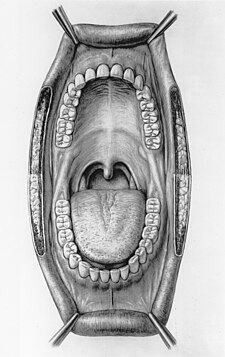Posterior tongue
| Tongue | |
|---|---|

The human tongue
|
|

Medical illustration of a human mouth by Duncan Kenneth Winter.
|
|
| Details | |
| Precursor | pharyngeal arches, lateral lingual swelling, tuberculum impar |
| Artery | lingual, tonsillar branch, ascending pharyngeal |
| Vein | lingual |
| Nerve | Sensory: Anterior 2/3: lingual nerve & chorda tympani Posterior 1/3: Glossopharyngeal nerve (IX) Motor Innervation: - CN XII (Hypoglossal) except palatoglossus muscle CN X (Vagus) |
| Lymph | Deep Cervical, Submandibular, Submental |
| Identifiers | |
| Latin | lingua |
| MeSH | A03.556.500.885 |
| Dorlands /Elsevier |
Tongue |
| TA | A05.1.04.001 |
| FMA | 54640 |
|
Anatomical terminology
[]
|
|
The tongue is a muscular organ in the mouth of most vertebrates that manipulates food for mastication, and is used in the act of swallowing. It is of importance in the digestive system and is the primary organ of taste in the gustatory system. The tongue's upper surface (dorsum) is covered in taste buds housed in numerous lingual papillae. It is sensitive and kept moist by saliva, and is richly supplied with nerves and blood vessels. The tongue also serves as a natural means of cleaning the teeth. A major function of the tongue is the enabling of speech in humans and vocalization in other animals.
The human tongue is divided into two parts, an oral part at the front and a pharyngeal part at the back. The left and right sides are also separated along most of its length by a vertical section of fibrous tissue (the lingual septum) that results in a groove, the median sulcus on the tongue's surface.
There are two groups of muscles of the tongue. The four intrinsic muscles alter the shape of the tongue and are not attached to bone. The four paired extrinsic muscles change the position of the tongue and are anchored to bone.
The tongue is a muscular hydrostat that forms part of the floor of the oral cavity. The left and right sides of the tongue are separated by a vertical section of fibrous tissue known as the lingual septum. This division is along the length of the tongue save for the very back of the pharyngeal part and is visible as a groove called the median sulcus. The human tongue is divided into anterior and posterior parts by the terminal sulcus which is a V-shaped groove. The apex of the terminal sulcus is marked by a blind foramen, the foramen cecum, which is the remnant of median thyroid diverticulum in early embryonic development. The anterior oral part is the visible part situated at the front and makes up roughly two-thirds the length of the tongue. The posterior pharyngeal part is the part closest to the throat, roughly one-third of its length. These parts differ in terms of their embryological development and nerve supply.
...
Wikipedia
